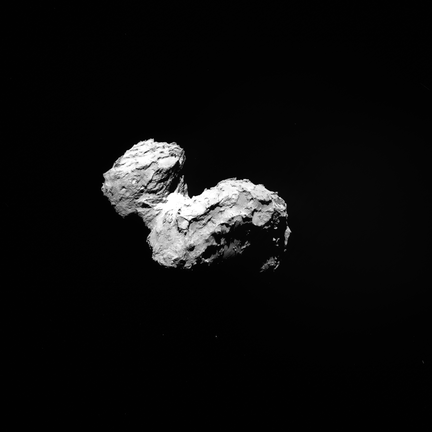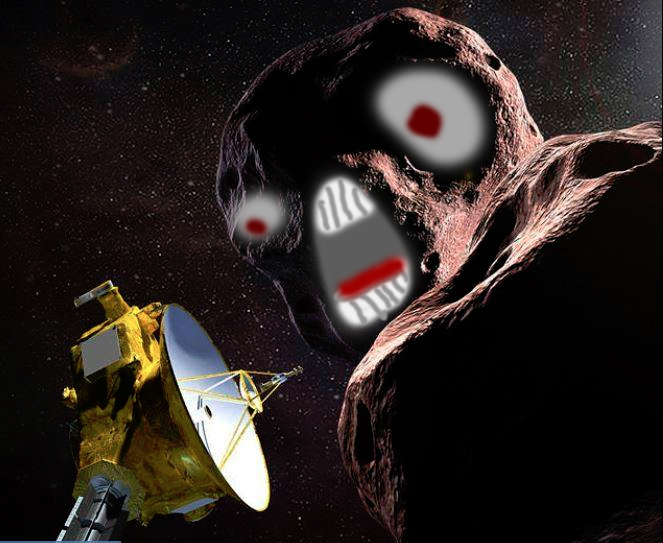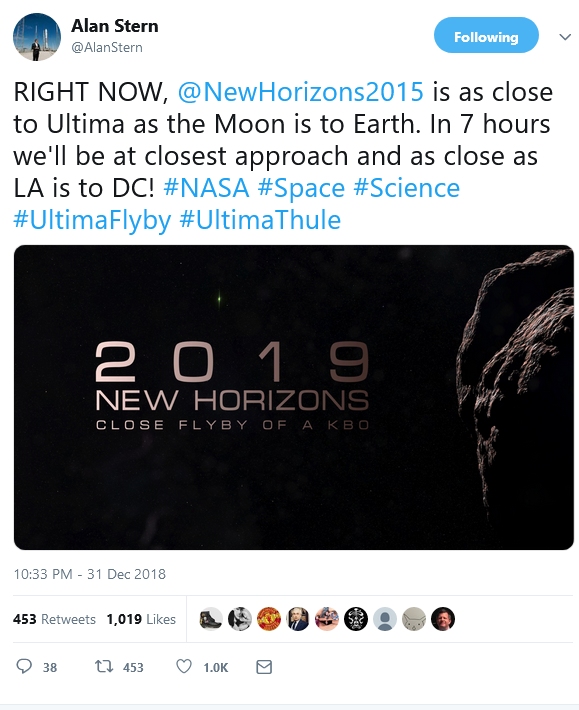It looks like you're using an Ad Blocker.
Please white-list or disable AboveTopSecret.com in your ad-blocking tool.
Thank you.
Some features of ATS will be disabled while you continue to use an ad-blocker.
share:
With no apparent hazards in its way, NASA's New Horizons spacecraft has been given a "go" to stay on its optimal path to Ultima Thule as it speeds closer to a Jan. 1 flyby of the Kuiper Belt object a billion miles beyond Pluto – the farthest planetary flyby in history.
After almost three weeks of sensitive searches for rings, small moons and other potential hazards around the object, New Horizons Principal Investigator Alan Stern gave the "all clear" for the spacecraft to remain on a path that takes it about 2,200 miles (3,500 kilometers) from Ultima, instead of a hazard-avoiding detour that would have pushed it three times farther out. With New Horizons blazing though space at some 31,500 miles (50,700 kilometers) per hour, a particle as small as a grain of rice could be lethal to the piano-sized probe.
solarsystem.nasa.gov, news, Dec. 18, 2018 - New Horizons spacecraft takes the inside course to Ultima Thule.
Happy New Year! A bit early I guess...
But lets review all the recent stories, all here on ATS:
* Voyager 2 enters interstellar space
* Farout discovered
* Parker Solar Probe Closest Manmade object to Sun
* Bennu To Be Sampled
* Hayabusa Sends Images, 200+, From Asteroid
Those are just plain vanilla discoveries! Add in rodent on Mars rocks... well, the point is that the discoveries just keep piling on!
Now New Horizons is going to the Kuiper Belt and image a strange object that is either of bi-lobe shape or elongated and strange enough to give Hubble a fit on determining its exact shape.
The path they are talking about in the article is one of two trajectories New Horizons can take on the fly-by. Today was the last day for a correction to the second path. Now it is set and we will have a closer flyby because the amount of dust around the area does not look too crowded.
The nickname is "Ultimate Thule" which is Latin for "furthest Thule" and is a fun little rabbit hole to go down (also at Wikipedia). Basically, early travelers would come back with tales of fabulous lands but warned about venturing too far out because everything there turned into a mixture of air, water, and land, and was like jellyfish. Reminds me of a certain reddit story about "flesh interfaces"! Anybody read Pynchon? There is a little Easter Egg for you too!
There is way more to read at the Wikipedia page: (486958) 2014 MU69, where they explain which telescopes were used to check for dust, why they had to use Hubble, various transits giving Ultimate Thule it's weird shape (it may even be two spherical objects packed together!), etc.
A nice way to kick off the New Year with a new discovery out on the edge of the solar system!! And more to come in the New Year!
New Horizons will make its historic close approach to Ultima Thule at 12:33 a.m. EST on Jan. 1—the first ever flyby of a Kuiper Belt object.
(same source)
ETA: For completeness. I forgot, they buried the lead and was off on a tangent...
120 AU, 43 AU...
Yeah, still a long, long walk home.
This is exciting stuff, and I'm really looking forward to the photo's.
Yeah, still a long, long walk home.
This is exciting stuff, and I'm really looking forward to the photo's.
originally posted by: TEOTWAWKIAIFF
New Horizons will make its historic close approach to Ultima Thule at 12:33 a.m. EST on Jan. 1—the first ever flyby of a Kuiper Belt object.
(same source)
ETA: For completeness. I forgot, they buried the lead and was off on a tangent...
Gives me a great reason to stay awake past the Times Square Ball Drop.
Note to self: Lay off the booze a bit so I don't fall asleep.
edit on 12/19/2018 by Soylent Green Is People because: (no reason given)
a reply to: Soylent Green Is People
Over on the waaaaay left coast, I get to check it out at a reasonable 8:33 PM (local) and then get ready to go out!
Usually it is the other way around and things happen before I am even awake! The teeter totter is my favor this time! (Totally missed the comet due to clouds... win some, lose some)
Over on the waaaaay left coast, I get to check it out at a reasonable 8:33 PM (local) and then get ready to go out!
Usually it is the other way around and things happen before I am even awake! The teeter totter is my favor this time! (Totally missed the comet due to clouds... win some, lose some)
a reply to: humanoidlord
Ultima Thule??
There are several different common usages. In respects to maps/travelling it is the "furthest north" of known lands. You know, "Here Be Sea Monsters" stuff.
It is also used in literature to denote some far away place. Like "lost horizon" has "Shangri la" or the place known as "utopia" (which is actually a play on words in Greek, where the word mean "no place")
There is also a Swedish metal band!!
Ultima Thule??
There are several different common usages. In respects to maps/travelling it is the "furthest north" of known lands. You know, "Here Be Sea Monsters" stuff.
It is also used in literature to denote some far away place. Like "lost horizon" has "Shangri la" or the place known as "utopia" (which is actually a play on words in Greek, where the word mean "no place")
There is also a Swedish metal band!!
a reply to: TEOTWAWKIAIFF
Another great thread.
Brian May of Queen will be premiering his new single at NASA HQ on Jan 1st.
here[ editby]edit on 20-12-2018 by blackcrowe because: (no reason given)
Another great thread.
Brian May of Queen will be premiering his new single at NASA HQ on Jan 1st.
here[ editby]edit on 20-12-2018 by blackcrowe because: (no reason given)
a reply to: blackcrowe
YouTube - Brian May - New Horizons (Preview)
Awesome! A minute clip of the song and an animation of New Horizons flying out to Pluto. Found it on Guitar World!!
Now if we can get some Satch and Surfing With The Alien we'd really be rocking!!
YouTube - Brian May - New Horizons (Preview)
Awesome! A minute clip of the song and an animation of New Horizons flying out to Pluto. Found it on Guitar World!!
Now if we can get some Satch and Surfing With The Alien we'd really be rocking!!
New Horizons will make its historic close approach to Ultima Thule at 12:33 a.m. EST on Jan. 1—the first ever flyby of a Kuiper Belt object
Technically, Pluto is the first Kuiper Belt object to have been visited by a spacecraft.
There will be a fly-by preview press briefing today, Friday 28 December, at 1:00 PM EST/18:00 UTC.
I'm not sure if NASA TV is affected by the government shut-down (although it seems to be on at the moment, but I don't know it they will air the press briefing), but there is an alternate viewing option, which is Johns Hopkins Applied Physics Lab (APL) YouTube channel. Johns Hopkins APL designed and operates the spacecraft.
Johns Hopkins "Where to Watch" page
Johns Hopkins APL YouTube Channel
NASA TV (if not affected by the shutdown)
As already mentioned in this thread, New Horizon's closest approach to asteroid (486958) 2014 MU69 Ultima Thule will be on New Year's day at 12:33 AM EST/05:33 UTC -- although according to Johns Hopkins' schedule, they won't be getting the "I'm OK" signal or any photographs until 10 hours later. So there might bot be a lot to see at 12:33 EST/05:33 UTC on New Years day, except maybe a simulation.
[Edit to add info]:
That delay is for a couple of reasons. (1) New Horizons will not send the signal right away. It will need to be oriented in a certain postion to take pictures and gather data -- but an orientation that is not the proper one for sending data back to Earth. Once done taking pictures, the craft will o turn itself toward earth to send the data, and (2) New Horizons is more than 6 light-hours away from Earth, so it will take more than 6 hours for those signals to reach us once sent.
So a combination of factors will make us wait 10 hours and longer for information -- and maybe an image soon after?
If NASA TV is out of service during the press briefings that follow on January 1 and 2, they can be seen on John Hopkins' YouTube channel as well.
I'm not sure if NASA TV is affected by the government shut-down (although it seems to be on at the moment, but I don't know it they will air the press briefing), but there is an alternate viewing option, which is Johns Hopkins Applied Physics Lab (APL) YouTube channel. Johns Hopkins APL designed and operates the spacecraft.
Johns Hopkins "Where to Watch" page
Johns Hopkins APL YouTube Channel
NASA TV (if not affected by the shutdown)
As already mentioned in this thread, New Horizon's closest approach to asteroid (486958) 2014 MU69 Ultima Thule will be on New Year's day at 12:33 AM EST/05:33 UTC -- although according to Johns Hopkins' schedule, they won't be getting the "I'm OK" signal or any photographs until 10 hours later. So there might bot be a lot to see at 12:33 EST/05:33 UTC on New Years day, except maybe a simulation.
[Edit to add info]:
That delay is for a couple of reasons. (1) New Horizons will not send the signal right away. It will need to be oriented in a certain postion to take pictures and gather data -- but an orientation that is not the proper one for sending data back to Earth. Once done taking pictures, the craft will o turn itself toward earth to send the data, and (2) New Horizons is more than 6 light-hours away from Earth, so it will take more than 6 hours for those signals to reach us once sent.
So a combination of factors will make us wait 10 hours and longer for information -- and maybe an image soon after?
If NASA TV is out of service during the press briefings that follow on January 1 and 2, they can be seen on John Hopkins' YouTube channel as well.
edit on 12/28/2018 by Soylent Green Is People because: (no reason given)
a reply to: Soylent Green Is People
It's a combo of both. First with Ultima Thule being around 43 AU away, it takes something like 6.5 hours for any signal to reach us.
I believe that it will do all it's science and imaging during it's flyby, and then after it's done reorientate to send that data to Earth, which will not only take all those hours to reach us, but many hours to send all that data.
My personal prediction is that Ultima Thule is going to look a bit like Comet 67P/Churyumov-Gerasimenko:

Just guessing here based upon the wobble/lopsidedness that they detected with it.
But we'll see, If nothing else, what objects in the outer solar system has taught us is they are not bland or humdrum objects to look at.
It's a combo of both. First with Ultima Thule being around 43 AU away, it takes something like 6.5 hours for any signal to reach us.
I believe that it will do all it's science and imaging during it's flyby, and then after it's done reorientate to send that data to Earth, which will not only take all those hours to reach us, but many hours to send all that data.
My personal prediction is that Ultima Thule is going to look a bit like Comet 67P/Churyumov-Gerasimenko:

Just guessing here based upon the wobble/lopsidedness that they detected with it.
But we'll see, If nothing else, what objects in the outer solar system has taught us is they are not bland or humdrum objects to look at.
originally posted by: eriktheawful
a reply to: Soylent Green Is People
It's a combo of both. First with Ultima Thule being around 43 AU away, it takes something like 6.5 hours for any signal to reach us.
I believe that it will do all it's science and imaging during it's flyby, and then after it's done reorientate to send that data to Earth, which will not only take all those hours to reach us, but many hours to send all that data.
My personal prediction is that Ultima Thule is going to look a bit like Comet 67P/Churyumov-Gerasimenko:
Just guessing here based upon the wobble/lopsidedness that they detected with it.
But we'll see, If nothing else, what objects in the outer solar system has taught us is they are not bland or humdrum objects to look at.
Thanks, Erik. As soon as I posted that, I found the information I was looking for about the delay and I edited my post accordingly (probably before you posted).
I wonder what surprises New Horizon will find during the flyby...



Credit: NASA, New Horizons Long Range Reconnaissance Imager (LORRI)
"It is called an 'appetizer', Starvin' Marvin, it is what we eat before we eat to make us more hungry..."
LORRI image from Christmas Eve on approach to UT. Originally from spaceweather.com the other day (lord knows where they put the daily main page stuff! I just found several mission pages poking around on the site... today!!)
Don't forget to follow Alan Stern on Twitter for the latest updates and retweets from fellow researchers.

The raw images gallery is now open at pluto.jhuapl.edu... The images so far aren't much to look at, but soon they will be.
That's one very exciting start to a new year!
And a Chinese lander and a rover will be landing on the Far Side of the Moon in a few days!

The raw images gallery is now open at pluto.jhuapl.edu... The images so far aren't much to look at, but soon they will be.
That's one very exciting start to a new year!
And a Chinese lander and a rover will be landing on the Far Side of the Moon in a few days!
edit on 1-1-2019 by wildespace because: (no reason
given)
